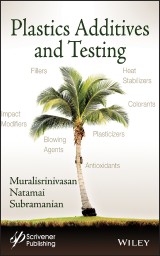Details

Plastics Additives and Testing
Polymer Science and Plastics Engineering 1. Aufl.
|
140,99 € |
|
| Verlag: | Wiley |
| Format: | EPUB |
| Veröffentl.: | 18.04.2013 |
| ISBN/EAN: | 9781118710555 |
| Sprache: | englisch |
| Anzahl Seiten: | 240 |
DRM-geschütztes eBook, Sie benötigen z.B. Adobe Digital Editions und eine Adobe ID zum Lesen.
Beschreibungen
<p><i>“Plastics Additives and Testing”</i> is a practical book for engineers and operators and discusses both inorganic and organic chemicals that are widely used as additives in plastics processing operations.</p> <p>It is common practice today to use analytical techniques to improve plastics processing. Because it is critically important to manufacture quality products, a reasonable balance must be drawn between control requirements and parameters for improved processing method with respect to plastics additives. This book serves to implement this balance in the manufacturing line.</p> <p>Written by a successful, international consultant with an excellent publishing track record, it combines plastics additives, testing and quality control and is a valuable and critical book for engineers and operators to have when performing their tasks.</p>
<p>Preface xiii</p> <p><b>1 Introduction 1</b></p> <p>1.1 Summary 4</p> <p>References 4</p> <p><b>2 Thermoplastics and Thermosets 5</b></p> <p>2.1 Benefits/Advantages of Plastics 5</p> <p>2.2 Classification 7</p> <p>2.3 Thermoplastics 7</p> <p>2.4 Thermosets 22</p> <p><b>3 Types of Additives 35</b></p> <p>3.1 Selection of Additives 36</p> <p>3.2 Surface Property Modifiers 36</p> <p>3.3 Chemical Property Modifiers 40</p> <p>3.4 Processing Modifiers 45</p> <p>3.5 Mechanical Property Modifiers 53</p> <p>3.6 Aesthetic Property Modifiers 59</p> <p>3.7 Other Additives 61</p> <p>3.8 Additives from Natural Sources 64</p> <p>References 65</p> <p><b>4 Plastics Additive and Chemistry 73</b></p> <p>4.1 Properties of Plastics 74</p> <p>4.2 Chemistry of Additives 74</p> <p>4.3 Chemical Properties of Additives 75</p> <p>References 94</p> <p><b>5 Organic Additives 101</b></p> <p>5.1 Antioxidants 102</p> <p>5.2 Antistatic Agents 102</p> <p>5.3 Antifogging Agents 103</p> <p>5.4 Antiblocking Agents 104</p> <p>5.5 Slip Additives 105</p> <p>5.6 UV Stabilizers 105</p> <p>5.7 Nucleating Agents 107</p> <p>5.8 Flame Retardants 107</p> <p>5.9 Lubricants 110</p> <p>5.10 Plasticizers 112</p> <p>5.11 Impact Modifiers 113</p> <p>5.12 Fillers 113</p> <p>5.13 Organic Colorants 115</p> <p>5.14 Foaming Agents 117</p> <p>5.15 Chain Extenders 118</p> <p>5.16 Organic Peroxides 118</p> <p>5.17 Accelerators 119</p> <p>5.18 Activators 119</p> <p>References 120</p> <p><b>6 Inorganic Additives 125</b></p> <p>6.1 Heat Stabilizers 126</p> <p>6.2 Flame Retardants 127</p> <p>6.3 Fillers 128</p> <p>6.4 Blowing Agents 137</p> <p>6.5 Inorganic Colorants 138</p> <p>6.6 Antimicrobial Agents 139</p> <p>References 140</p> <p><b>7 Additives and Processing 145</b></p> <p>7.1 Plastics Processing 145</p> <p>7.2 Nature of Plastics 146</p> <p>7.3 Nature of Additives 148</p> <p>7.4 Plastics Processing Technology 149</p> <p>7.5 Injection Molding 150</p> <p>7.6 Extrusion 153</p> <p>7.7 Blow Molding 157</p> <p>7.8 Thermoforming 157</p> <p>7.9 Role of Additive 158</p> <p>7.10 Rotational Molding 159</p> <p>7.11 Calendering 160</p> <p>7.12 Thermosets and Processing 161</p> <p>References 163</p> <p><b>8 Identification of Additives 167</b></p> <p>8.1 Melting and Boiling Point 168</p> <p>8.2 Organic Additives 168</p> <p>8.3 Inorganic Additives 171</p> <p>8.4 Morphology 173</p> <p>8.5 Mass Spectrometry 173</p> <p>8.6 Scanning Electron Microscopy (SEM) 173</p> <p>8.7 Benefits 174</p> <p>References 174</p> <p><b>9 Testing of Additives 177</b></p> <p>9.1 Plastics and Additives in Analysis 178</p> <p>9.2 Properties of Additives 178</p> <p>9.3 Testing of Additives 179</p> <p>9.4 Brabender Plastographs 179</p> <p>9.5 Extraction of Polymer Additives Systems 181</p> <p>9.6 Liquid Chromatography 184</p> <p>9.7 Gas Chromatography 186</p> <p>9.8 Thermal Analysis 189</p> <p>9.9 Thermogravimetric-Mass Spectrometry 192</p> <p>9.10 FTIR Spectroscopy 194</p> <p>9.11 Quantitative Analysis of Additives 196</p> <p>9.12 Quality Control 198</p> <p>References 199</p> <p><b>10 Future Trends 203</b></p> <p>10.1 In Plastics Packaging 204</p> <p>10.2 In Medicine 204</p> <p>10.3 In Electrical and Electronics Industries 205</p> <p>10.4 In Building 205</p> <p>10.5 In Engineering 205</p> <p>10.6 Present Trends 206</p> <p>10.7 Future Requirements 208</p> <p>References 209</p> <p>Index 000</p>
<p><b>Muralisrinivasan Subramanian</b> is a plastics technology consultant specializing in materials, additives, and processing equipment, including troubleshooting. He obtained his BSc in chemistry from the Madurai Kamaraj University and his MSc in polymer technology from Bharathiar University. He received his postgraduate diploma in plastics processing technology from CIPET, Chennai. He has also completed his PhD in polymer science from Madurai Kamaraj University. Dr. Subramanian worked in the plastic process industry, mainly in R & D, for thirteen years before turning to consultancy and building up an international client base. He teaches plastics processing seminars as well as being a Board of Studies expert member of colleges in India, advising on curriculum issues with regard to technology subjects.</p>
<p><b>Presents a thorough overview of the many types of plastics additives, the multiple testing techniques used by industry, as well as the quality control measures to ensure the formulation will result in high-quality product.</b></p> <p>It is common practice today to use analytical techniques to improve plastics processing. Because it is critically important to manufacture quality products, a reasonable balance must be drawn between control requirements and parameters for improved processing methods with respect to plastics additives. This book speaks to implementing this balance in the manufacturing line.</p> <p><i>Plastics Additives and Testing</i> is a practical book for engineers and operators. It discusses both inorganic and organic chemicals that are widely used as additives in plastics processing operations. Testing the formulation is now an integral part of the process so that the raw materials used in plastics processing are subject to quality control. Instrumental methods used in plastics additive testing have the ability to control experiments on plastics processing, collect data, and perform calculations, as well as provide increased efficiency and reduce waste during processing.</p> <p>This important and concise book written by an expert practitioner elucidates the complex yet broadening world of plastics additives and the testing techniques. Highlights include:</p> <ul> <li>The various types of additives as well as their chemistry</li> <li>Organic and inorganic additives</li> <li>Additives and the multiple plastics processes</li> <li>The identification of additives</li> <li>The testing of additives through various systems such as thermogravimetric mass spectrometry, gas chromatography, and FTIR spectroscopy</li> </ul> <p><b>Readership</b><br /> <i>Plastics Additives and Testing</i> is aimed at industry and manufacturing such as operators, formulators, processors, engineers, and chemists. In addition, the book is ideal for technical seminars in industry or courses in engineering and technology schools that teach polymers or plastics technology at both the graduate and postgraduate levels.</p>

















